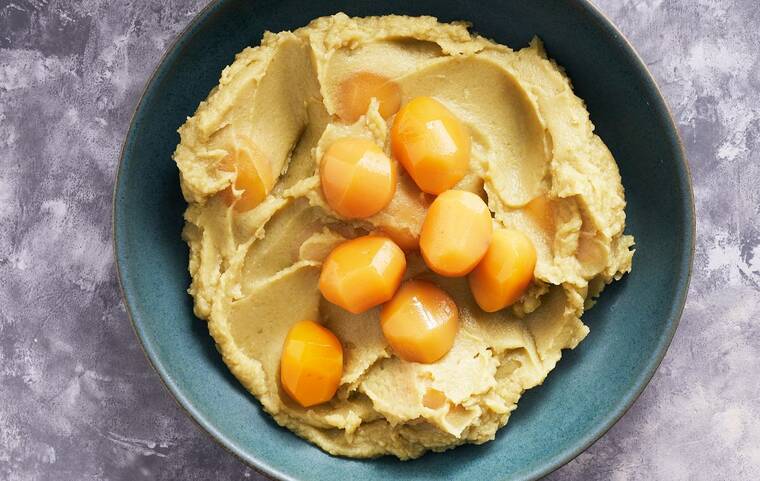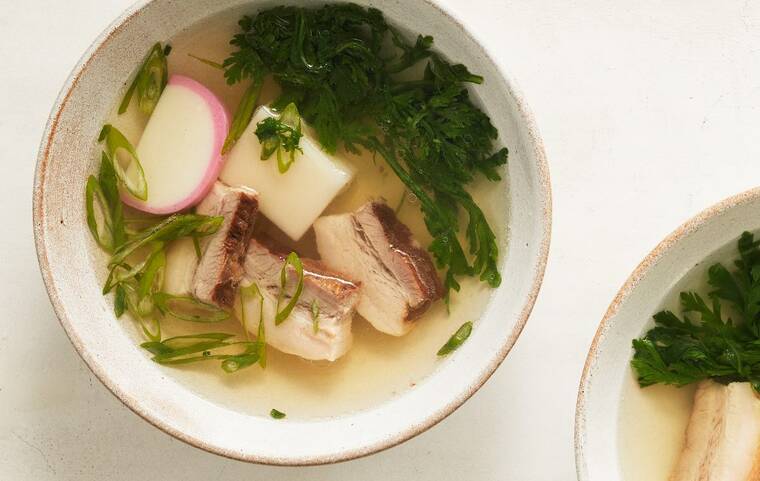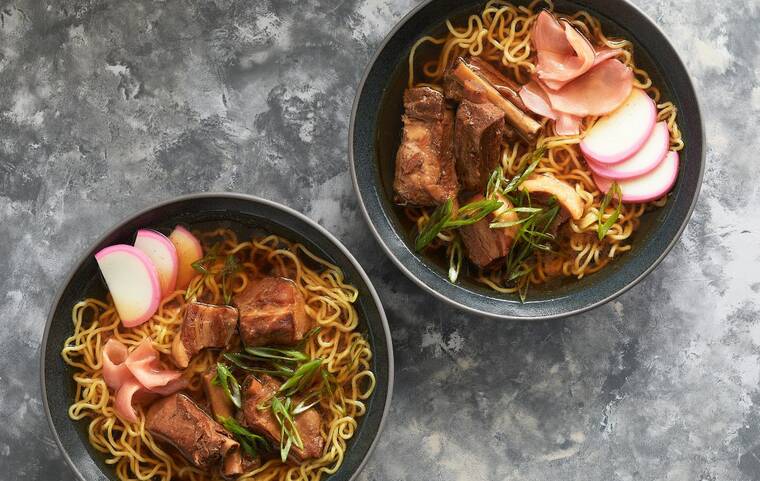Japanese American New Year’s food traditions transcend time

KERRI BREWER/THE NEW YORK TIMES
Kurikinton (Japanese Sweet Potatoes and Candied Chestnuts). Candied chestnuts lend a golden hue to mashed white sweet potatoes. Food styled by Barrett Washburne.

KERRI BREWER/THE NEW YORK TIMES
Ozoni (New Year Mochi Soup). Mochi adds a satisfying chew against the warming broth. Food styled by Barrett Washburne.

KERRI BREWER/THE NEW YORK TIMES
Okinawan Soba. Okinawan soba is made with wheat-based noodles, which signifies longevity for the new year. Food styled by Barrett Washburne.



Jane Matsumoto’s family is so eager to eat their annual ozoni that they gather around the table at 2 in the morning, right after they’ve cleaned the confetti, streamers and Champagne glasses from their New Year’s Eve festivities. Matsumoto, who is sansei, or third-generation Japanese American, and the executive culinary director of the Japanese American Cultural & Community Center in Los Angeles, looks forward to the brothy soup bobbing with mochi pieces every year.
Ozoni is standard New Year’s Day fare for many Japanese Americans, whether they are nisei, the children of Japanese immigrants, or hansei, fourth-generation Japanese Americans. Starting in the 1880s, the first major wave of Japanese immigrants arrived in the United States, and although many New Year’s Day tables have evolved to include dishes from other cultures, customary Japanese dishes remain.
As a child, chef Charles Namba patiently toasted squares of mochi every New Year’s Day over the ceramic grates of a floor heater in his home in Los Angeles. The smooth, white cubes of pounded steamed rice would develop a gentle char and inflate like a small balloon after enough time over the heat. They were then dropped into a comforting bowl of ozoni studded with hunks of chicken, wilted spinach and shiitake mushrooms. His family found it especially nourishing after a night spent stuffing themselves with cookies and watching the Times Square ball drop on television.
The soup is also “super important” to chef Chris Ono of Hansei, a pop-up in the same Los Angeles cultural center where Matsumoto works, and his family. Ono said it was something they made every year, taking care to even get their mochi from the local Buddhist temple.
Steven Pursley, chef and owner of Menya Rui in St. Louis, spends the first day of the year eating yet another type of soup: Okinawan soba. The gentle broth, made from dashi and pork, is a great base for the wheat-based soba commonly eaten in Okinawa, off the southern coast of mainland Japan. In America, Pursley’s resourceful mother sometimes used linguine when she wasn’t able to find Okinawan soba. Now he makes the noodles from scratch.
Namba is also fond of eating soba — the more well-known buckwheat version — making special versions with lobster tempura or duck for New Year’s at his Los Angeles restaurants Tsubaki and Ototo.
Don't miss out on what's happening!
Stay in touch with breaking news, as it happens, conveniently in your email inbox. It's FREE!
As with many global New Year’s traditions, the dishes have strong symbolic meanings. Ozoni is associated with good health and good fortune, with the mochi signifying longevity. Soba noodles represent breaking ties with the hardships of the previous year and starting anew, Pursley said, as well as a long life.
Perhaps the best example of symbolic Japanese New Year foods is osechi ryori, or a box filled with an assortment of traditional New Year’s dishes, each with a specific meaning. Each year, chef Niki Nakayama serves a version at her restaurant n/naka in Los Angeles. She includes kuromame, or sweet black soybeans, a wish for good health; datemaki, or a Japanese rolled omelet, that looks like a scroll for the acquisition of knowledge; and kurikinton, a vibrant mash of Japanese sweet potatoes flavored with candied chestnut syrup and topped with the golden candied chestnuts, which represent gold and bring economic fortune.
Chef Jesse Ito’s father, Masaharu Ito, also cooked an elaborate osechi ryori at his restaurant Fuji, which he opened in south New Jersey, just outside Philadelphia, in 1979 and ran for 37 years. Masaharu, exhausted from cooking a full osechi ryori at the restaurant, celebrated with something simpler at home: oyakodon, an easy chicken-and-egg rice dish which Jesse called “the ultimate Japanese comfort food.” But Masaharu was most excited to make something a bit more local: hoagies. He bought bread from the Wawa convenience store chain and stacked it with cold cuts, provolone and a generous amount of olives. “They were terrific,” Ito said fondly.
It’s not uncommon for Japanese American New Year’s tables to include other culinary influences. “Third- and fourth-generation Japanese Americans started to incorporate foods that were familiar to the Japanese American communities they grew up in,” said Matsumoto, whose grandparents immigrated to the United States. As with the hoagies in South Jersey, it’s not rare to find tamales on the table in Los Angeles, or pies and tubs of ice cream for dessert across America.
Chinese dishes such as chow mein and wontons are also a staple of many Japanese American New Years gatherings. “Chinese food has historically been a part of Japanese communities,” Matsumoto said. After Japanese Americans were released from the internment camps in 1946, Chinese restaurants were some of the few places to welcome them immediately, she said, adding, “It was a safe haven.” This is why Ono sometimes makes his ozoni with char siu, the Chinese dish of barbecued pork.
Still, most Japanese American New Year’s tables remain quite traditional, with the recipes staying the same as they are passed down from one generation to the next. It’s one of the ways Japanese Americans maintain a connection to their roots and their past. Ono hopes to serve an osechi riyori at his restaurant next year — one that is affordable, starring more local California produce.
But he wants to make sure he doesn’t deviate too far from long-established customs, given that each dish has a symbolic meaning and is often tied to luck: “You don’t want to mess with that.”
Recipe: Ozoni (New Year Mochi Soup)
Recipe from Chris Ono
Adapted by Khushbu Shah
Typically consumed just once a year on New Year’s Day, this brothy soup is comforting and nourishing. It’s also said to bring good luck and good fortune to those who eat it. Ozoni is highly customizable, but it must always contain pieces of chewy mochi. The rice cakes are traditionally pounded by hand but are now sold already prepared and are easy to find in Japanese markets around the New Year. This version from chef Chris Ono includes pork belly that simmers in a mix of dashi, soy sauce, sake and ginger until tender. To balance that richness, he serves this soup with lots of mizuna leaves, which can easily be substituted with spinach. — Khushbu Shah
Yield: 8 servings
Total time: 3 hours, 50 minutes
Ingredients:
1 ounce kombu
1 3/4 ounces bonito (skipjack tuna) flakes (katsuobushi)
2 cups soy sauce
1 cup sake
1/2 cup mirin
1/2 cup sugar
1 (5-inch) piece fresh ginger, peeled and thickly sliced
2 pounds pork belly without skin
6 ounces mizuna, cut in 2-inch lengths, or spinach
8 pieces fresh or thawed frozen mochi squares (see Tip)
3 ounces fish cake (kamaboko), cut into 8 (1/4-inch) slices
4 scallions, thinly sliced
Preparation:
1. In a large pot, combine 18 cups water and the kombu and cook over moderately high heat until barely simmering, about 10 minutes. Remove from the heat and let steep for 1 hour. Remove the kombu.
2. Bring the kombu liquid to a boil. Add the bonito flakes, turn off the heat and let steep for 5 minutes. Pour the kombu-bonito dashi into a clean pot through a fine strainer.
3. In a large saucepan, combine 4 cups of the strained dashi with the soy sauce, sake, mirin, sugar and ginger; whisk to dissolve the sugar. Add the pork belly and bring to a boil over high heat. Reduce the heat to maintain a simmer and cook until the pork belly is tender, about 2 hours. Transfer the pork belly to a cutting board and let cool slightly. Cut the pork belly into 24 slices.
4. Meanwhile, cook the mizuna in a medium pot of boiling water for 1 minute. Drain and rinse under cold water to stop the cooking. Form the mizuna into 8 small bundles.
5. Assemble the ozoni: Bring the dashi to a simmer. In each of 8 bowls, arrange a mizuna bundle, a piece of fresh mochi, a slice of fish cake, 3 slices of pork belly and about a tablespoon of scallions. Pour the hot dashi on top and serve at once.
Tip:
If you can find only dried mochi, microwave it for 35 to 40 seconds until soft and stretchy.
Recipe: Okinawan Soba
Recipe from Steven Pursley
Adapted by Khushbu Shah
Although soba usually refers to buckwheat noodles, Okinawan soba uses wheat noodles that more closely resemble ramen. Chef Steven Pursley, whose family comes from the island prefecture off the Southern coast of mainland Japan, makes his own noodles from scratch. You can use store-bought fresh ramen noodles or another thicker Asian egg noodle for this soup, which gets its flavor from a delicate pork and bonito broth. You can find the noodles, kombu, sake, mirin, bonito, fish cake and pickled red ginger at Japanese markets or well-stocked Asian grocery stores.
Yield: 8 servings
Total time: 3 hours, 35 minutes
Ingredients:
1/2 ounce kombu
2 pounds pork riblets
2 pounds skinless fresh pork belly, cut in half
2 cups soy sauce, plus more for seasoning
1 cup sake
1 cup mirin
3/4 cup dark brown sugar (see Tips)
6 garlic cloves, peeled
1 (3-inch) piece fresh ginger, sliced into thick coins
2 ounces bonito (skipjack tuna) flakes (katsuobushi)
Salt
4 (10-ounce) packages fresh ramen noodles or other thicker Asian egg noodles
6 ounces fish cake (kamaboko), cut into 16 (1/4-inch-thick) slices
Red pickled ginger and thinly sliced scallions, for topping
Shichimi togarashi, for sprinkling (optional)
Preparation:
1. In a large bowl, cover the kombu with 6 1/4 cups water and set aside to soak while you cook the pork riblets and pork belly.
2. In a large pot, combine all of the pork and add water to cover. Bring to a boil over moderately high heat, skimming the surface to remove impurities. Reduce the heat and simmer the meat for 1 hour, skimming as necessary.
3. Using tongs, transfer the riblets and pork belly to a plate. Strain the pork broth into a heatproof bowl and set aside. Cut the pork belly crosswise into 1/2-inch-thick slices.
4. In a pot large enough to hold the riblets and pork belly with 2 inches of headroom, combine the soy sauce, sake, mirin, brown sugar, garlic, ginger and 2 cups water. Whisk to dissolve the sugar. Add all of the pork and bring to a simmer over moderately high heat. Reduce the heat as necessary to simmer until the meat is tender, rotating the pieces as needed to submerge and cook evenly, about 1 hour. Remove from the heat.
5. Meanwhile, in a large saucepan, combine the soaked kombu and its soaking water with 6 1/4 cups of the reserved pork broth. Cook over medium heat until it starts to steam, about 15 minutes. Using tongs, remove the kombu. Bring the broth to a boil over high heat, skimming as necessary. Remove from the heat and add the bonito flakes. Cover and let stand until the bonito sinks, about 8 minutes. Strain the broth into a clean saucepan and season with salt and soy sauce to taste. Skim the fat floating on top or chill the broth and remove the fat after it hardens. The broth and braised meat can be refrigerated in airtight containers for up to 3 days.
6. Assemble the bowls: Bring a large pot of water to a boil. Reheat the broth and the meat if necessary. Have all of your garnishes ready. Add the ramen to the boiling water and cook until springy, 4 to 5 minutes, stirring with a large fork to separate the noodles and break up any clumps. Drain well and divide among 8 wide or deep bowls. Pour the hot broth over the noodles and stir to prevent them from clumping. Top each serving with pork belly and riblets and slices of fish cake. Garnish with pickled ginger and scallions and serve with shichimi togarashi for sprinkling if you’d like.
Tips:
At his restaurant, Steven Pursley uses Okinawan black sugar. If you can find it, you can use it as well.
If the broth is too subtle for you, you can add some of the braising liquid from cooking the meat.
Recipe: Kurikinton (Japanese Sweet Potatoes and Candied Chestnuts)
Recipe from Niki Nakayama
Adapted by Khushbu Shah
A staple of osechi ryori, a box filled with a variety of traditional Japanese New Year’s dishes, kurikinton is said to represent gold and bring good economic fortune. Chef Niki Nakayama likes to imbue the Japanese sweet potatoes with a golden hue by simmering them with gardenia pods. If those are not available, a pinch of saffron works too. Do not discard the syrup that the candied chestnuts sit in; it’s used to flavor the mash. The candied chestnuts are available in Japanese markets, particularly around the New Year, and the white sweet potatoes with red skin are available in most supermarkets.
Yield: 4 to 8 servings (about 1 1/2 cups)
Total time: 1 hour, 35 minutes
Ingredients:
1 pound satsumaimo (Japanese white sweet potatoes)
1 tablespoon kuchinashi (gardenia pods), wrapped in cheesecloth, or a pinch of saffron threads
1 (200-gram) jar Japanese candied chestnuts in syrup
1 tablespoon mirin
Salt
Preparation:
1. Peel the potatoes and soak them in cold water to cover for 10 minutes to remove excess starch.
2. In a medium saucepan, cover the potatoes with fresh water and add the kuchinashi sachet. Bring to a boil over high heat, then reduce the heat and simmer until the potatoes are cooked through, about 50 minutes. Add more water to the saucepan as necessary to keep the potatoes submerged (otherwise, they may darken). When the potatoes are done, cut into large chunks.
3. Drain the chestnuts, reserving the syrup.
4. Puree the potatoes using a food mill or a ricer set over a bowl or mash by hand. Stir in the mirin and 1 1/2 tablespoons of the chestnut syrup and season to taste with salt. Stir in some of the chestnuts. Transfer to a beautiful bowl and serve at room temperature, with the remaining chestnuts on top.
This article originally appeared in The New York Times.
© 2023 The New York Times Company



